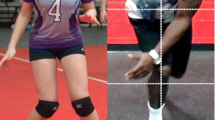Summary
Knee proprioception was assessed in 20 healthy volunteers, 10 patients with acute anterior instability and in 20 patients with chronic anterior instability preoperatively as well as after 3 and 6 months postoperatively. To determine proprioception, an angle reproduction test was performed. There were no differences between the right and the left knee joint or between men and women. Best proprioception was measured near full extension. The acute trauma causes massive damage of the proprioception, which could be improved significantely by rehabilitation. However, rehabilitation could not restore proprioception. 3 months postoperatively, there was a slight decrease of proprioception as compared to the preoperative values, but 6 months after reconstruction, restoration of proprioception was documented near full extension and full flexion. In the mid range position, the proprioception could not be restored. There was no difference between open and arthroscopic techniques. The highest correlation was found between proprioception and patient's satisfaction.
Zusammenfassung
Die Kniegelenkspropriozeption wurde an 20 gesunden Probanden, an 10 Patienten mit akuter vorderer Knieinstabilität und an 20 Patienten mit chronischer vorderer Instabilität anhand einer prospektiven Longitudinalstudie bestimmt. Die Messung erfolgte unter Verwendung des Winkelreproduktionstests bei einer konstanten Winkelgeschwindigkeit von 0,5 °/s. Bei den gesunden Probanden zeigte sich keine Abhängigkeit von Körperseitendominanz und Geschlecht. Die höchsten Propriozeptionswerte wurden im endgradigen Extensionsbereich ermittelt. Die Ruptur des vorderen Kreuzbandes führte in der Akutphase zur ausgeprägten Propriozeptionsstörung, welche sich bei chronischer vorderer Instabilität nach mehrmonatiger Rehabilitation zwar signifikant verbesserte, jedoch nicht wiederhergestellt werden konnte. 3 Monate postoperativ kam es in sämtlichen Bewegungsintervallen zu einer minimalen Propriozeptionsverschlechterung, während nach 6 Monaten in Extensionsnähe und nahe 90 ° Flexion eine komplette Propriozeptionsrestitution ermittelt wurde. Im mittleren Bewegungsintervall persistierte das Propriozeptionsdefizit. Eine Überlegenheit eines Operationsverfahrens (arthroskopisch vs. Miniarthrotomie) hinsichtlich der Propriozeption zeigte sich zu keinem Zeitpunkt. Daneben wurden eine hohe Korrelation zwischen Propriozeption und subjektiver Zufriedenheit festgestellt, was die große klinische Relevanz der Propriozeption unterstreicht.
Similar content being viewed by others
Author information
Authors and Affiliations
Rights and permissions
About this article
Cite this article
Fremerey, R., Lobenhoffer, P., Born, I. et al. The role of ACL reconstruction on restitution of proprioception in chronic anterior instability of the knee – a prospective longitudinal study. Unfallchirurg 101, 697–703 (1998). https://doi.org/10.1007/s001130050325
Published:
Issue Date:
DOI: https://doi.org/10.1007/s001130050325




